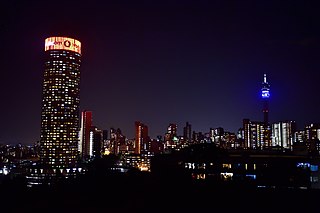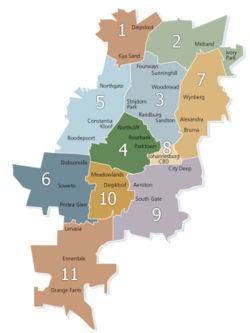
Johannesburg is the most populous city in South Africa with 4,803,262 people, and is classified as a megacity; it is one of the 100 largest urban areas in the world. It is the provincial capital and largest city of Gauteng, which is the wealthiest province in South Africa. Johannesburg is the seat of the Constitutional Court, the highest court in South Africa. Most of the major South African companies and banks have their head offices in Johannesburg. The city is located within the mineral-rich Witwatersrand hills, the epicentre of the international-scale mineral, gold and (specifically) diamond trade.

Gauteng is one of the nine provinces of South Africa.

Midrand is a former municipality in central Gauteng, South Africa. Situated in-between Centurion and Sandton, Midrand now forms part of the City of Johannesburg Metropolitan Municipality.

The term Greater Johannesburg may mean:

Region 1 was an administrative district in the City of Johannesburg, South Africa, from 2000 to 2006. It is known as the Diepsloot region. It bordered Region 2 (Midrand), Region 3 (Sandton), and Region 5 (Roodepoort). The region was abolished with a reorganisation of regions in 2006.

Region 3 was an administrative district in the City of Johannesburg, South Africa, from 2000 to 2006, and was also known as the Sandton region, as it included the formerly independent municipality of Sandton, and many of the northern suburbs of the former Johannesburg municipality. It bordered Region 1 (Diepsloot), Region 2 (Midrand), Region 7 (Alexandra), Region 8, Region 4 (Northcliff), and Region 5 (Roodepoort). The region was abolished with a reorganisation of regions in 2006.

Region 7 was an administrative district in the City of Johannesburg, South Africa, from 2000 to 2006. It included the densely populated Alexandra township and the town of Modderfontein and was one of Johannesburg's eastern boundary sections, situated in the north-east of the city. Regions 2 (Midrand), 3 (Sandton), and 8 (Central) were to its west, with Midrand also forming its northern boundary. It touched on Region 9 in the south. Its position gives it good access to the City's eastern neighbours, such as Kempton Park and Germiston. The region was abolished with a reorganisation of regions in 2006.

The suburbs of Johannesburg are officially demarcated areas within the City of Johannesburg Metropolitan Municipality, South Africa. As in other Commonwealth countries, the term suburb refers to a "neighbourhood", although in South Africa most "suburbs" have legally recognised borders and often separate postal codes. The municipal functions for the area, such as municipal policing and social services, are still managed by the city government.

Kempton Park is a city in the East Rand region of Gauteng province, South Africa. It is part of the City of Ekurhuleni Metropolitan Municipality. It is situated south of Tembisa, one of the largest townships in South Africa, which is also part of Ekurhuleni. South Africa's busiest airport, O. R. Tambo International Airport is located in Kempton Park.

Gautrain is an 80-kilometre (50-mile) higher-speed express commuter rail system in Gauteng, South Africa, which links Johannesburg, Pretoria, Kempton Park and O. R. Tambo International Airport. It takes 15 minutes to travel from Sandton to O. R. Tambo International Airport on the Gautrain and 35 minutes from Pretoria in Tshwane to Park Station in Johannesburg. The Gautrain has 10 stations. Buses, shuttles and midibus services are available to transport passengers to and from all stations excluding the O. R. Tambo International Airport Station.
Blue Hills is a suburb of Midrand, South Africa. It is located in Region A of the City of Johannesburg Metropolitan Municipality.
Crowthorne is a suburb of Midrand, South Africa. It is located in Region A of the City of Johannesburg Metropolitan Municipality, between Pretoria and Johannesburg on the previously known Carlswald Agricultural Holdings. The region is surrounded by plots, horse breeding societies and agricultural activities; neighbouring areas like Beaulieu, Kyalami, Blue Hills etc. Crowthorne is known for the Crowthorne Shopping Centre, Crowthorne Lodge, new developments by Century Property Developments and several garden centres like the Plantland Nursery.
Ebony Park is a suburb in Midrand, north-east of Johannesburg, South Africa. It is located in Region A of the City of Johannesburg Metropolitan Municipality, adjacent to Ivory Park.
Ivory Park is a densely populated residential suburb of Midrand in the Gauteng province of South Africa. It is located in Region A of the City of Johannesburg.
Kyalami Estates is a gated residential suburb of Midrand, South Africa. It is located in Region A of the City of Johannesburg Metropolitan Municipality. The suburb has a total of 994 houses with an average of about 4 people living in each house, although it can be varying.

The City of Johannesburg Metropolitan Municipality is a metropolitan municipality that manages the local governance of Johannesburg, the largest city in South Africa. It is divided into several branches and departments in order to expedite services for the city. Zulu is the most spoken home language at 23.4% followed by English at 20.1%.
Rabie Ridge is a township near Johannesburg, South Africa. It is located in Region A of the City of Johannesburg Metropolitan Municipality and is located east of Midrand. It is a township formed due to forced removals of the coloured community from Alexandra and is named after Jack Rabie.
Louis Botha Avenue is a major street in Johannesburg, South Africa. Originally part of the main road between central Johannesburg and Pretoria, it runs along through the north-eastern parts of the city from Hillbrow to Sandton, passing through numerous older suburbs, including Houghton and Orange Grove, before it becomes the Pretoria Main Road (R101) which passes the Alexandra Township and continues to Midrand and Pretoria.

Midrand is a metro station on the Gautrain rapid transit system in Midrand, Gauteng. It opened on 2 August 2011 as part of the second phase of the Gautrain project.
Olifantsfontein, also known as Clayville, is a small town on the East Rand in the Gauteng Province of South Africa. It is located at the north-western corner of the City of Ekurhuleni Metropolitan Municipality, just north of the Thembisa township. As of the 2011 Census, the town has a population of 14,526 people.










